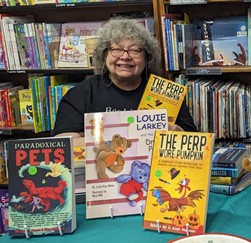 by Linda Kaye Hardie
by Linda Kaye Hardie
I used to teach core humanities at the University of Nevada, Reno, where we studied how our civilization came to be what it is. In the class we looked at history through the lenses of literature, art, music, and technology. My favorite class was always Ancient and Medieval History, because ancient times are full of heroes, and it’s a little bit like peering into a real-life Marvel Universe.
We’re used to seeing those thrilling stories in book form, but they began more like audiobooks, with storytellers speaking the action aloud to stadiums full of people. The stories weren’t written down until much later.
Medieval times are quite a change, though, with the Christian religion taking over much of the culture. Heroes change tremendously, from a wild nature-based magic to a still pretty wild kind of magic, but one based on the idea of needing to be saved by Christianity. This was when monks began copying religious books by hand, adding artistic flourishes. Each book took about a year to laboriously produce.
Unquestionably, books and stories have always been important to human history and culture.
A big question we needed to answer in this class toward the end of the semester is when does the medieval period end and modern times begin?
In my lecture about this issue, I list seven possible dates that various scholars consider the pivot point. For instance, we could say the medieval period ends in 1204 with the sack of Constantinople by the Fourth Crusade. Or perhaps in 1517, when Martin Luther and his hammer did a number on door of the Wittenberg All Saints’ Church with his 95 theses. Or even in 1569 with the birth of the Polish-Lithuanian Commonwealth.
Oh! Excuse me, I dozed off there for a moment.
I’m not even really sure what that last one is. I googled it once and tried to read the Wikipedia article, but I woke up drooling on my keyboard.
For me, it’s a big no to those and all the others. What seems obvious to me is that modern times begin with Gutenberg’s invention of the printing press in 1455. Sure, the Chinese used block printing three centuries earlier, but that was a slow, hand-produced process, not a way to mass-produce books. Gutenberg’s invention literally brought books, reading, and knowledge to the common people, and in 569 years, it hasn’t slackened.
Sure, it’s looked like reading has slowed down, and various Chicken Littles cry that the sky is falling many times. I went to college before personal computers, and the idea of a computer in everyone’s home, and now pocket, wasn’t on anyone’s radar. But that didn’t stop the old folks from criticizing how the youth spent their time. The bugaboo then was television, which was “destroying children’s minds and replacing reading,” as the naysayers kept saying. Later it was videogames leading to a dearth of and death to reading.
Now it’s smart phones and 24/7 access to the internet.
But you know what? Reading is as hot and trendy as ever. Reading started to increase right after the turn of the new century. A 2009 report by the National Endowment for the Arts said, “For the first time in over a quarter-century, our survey shows that literary reading has risen among adult Americans.”
Reading’s newfound popularity has continued. The Pew Research Center said 92 percent of college-educated adults in the United States were big readers in 2018. And COVID helped. Publisher’s Weekly reported that print book sales rose almost nine percent when the pandemic started in 2020. Pew also says that audiobooks remain popular, and ebooks are rising a bit, with 30 percent of Americans now reading those.
Books and reading are showing no signs of slipping into obscurity. Even though in my university classes I always warned against using logical fallacies in arguments, this is one bandwagon that it’s good to jump onto.
Have you read a good book lately? Try one!
Linda Kaye Hardie is vice president, Short Mystery Fiction Society. Her publications in magazines and anthologies include: AI, Robot, Purrseverance, Tales of the Apocalypse, The Perp Wore Pumpkin, Under Her Eye.
